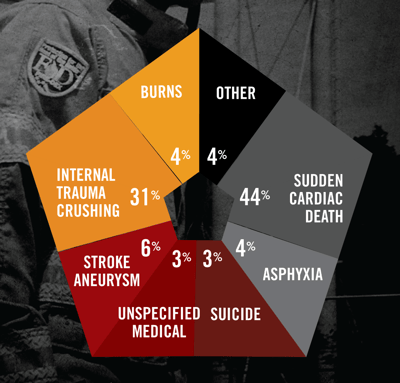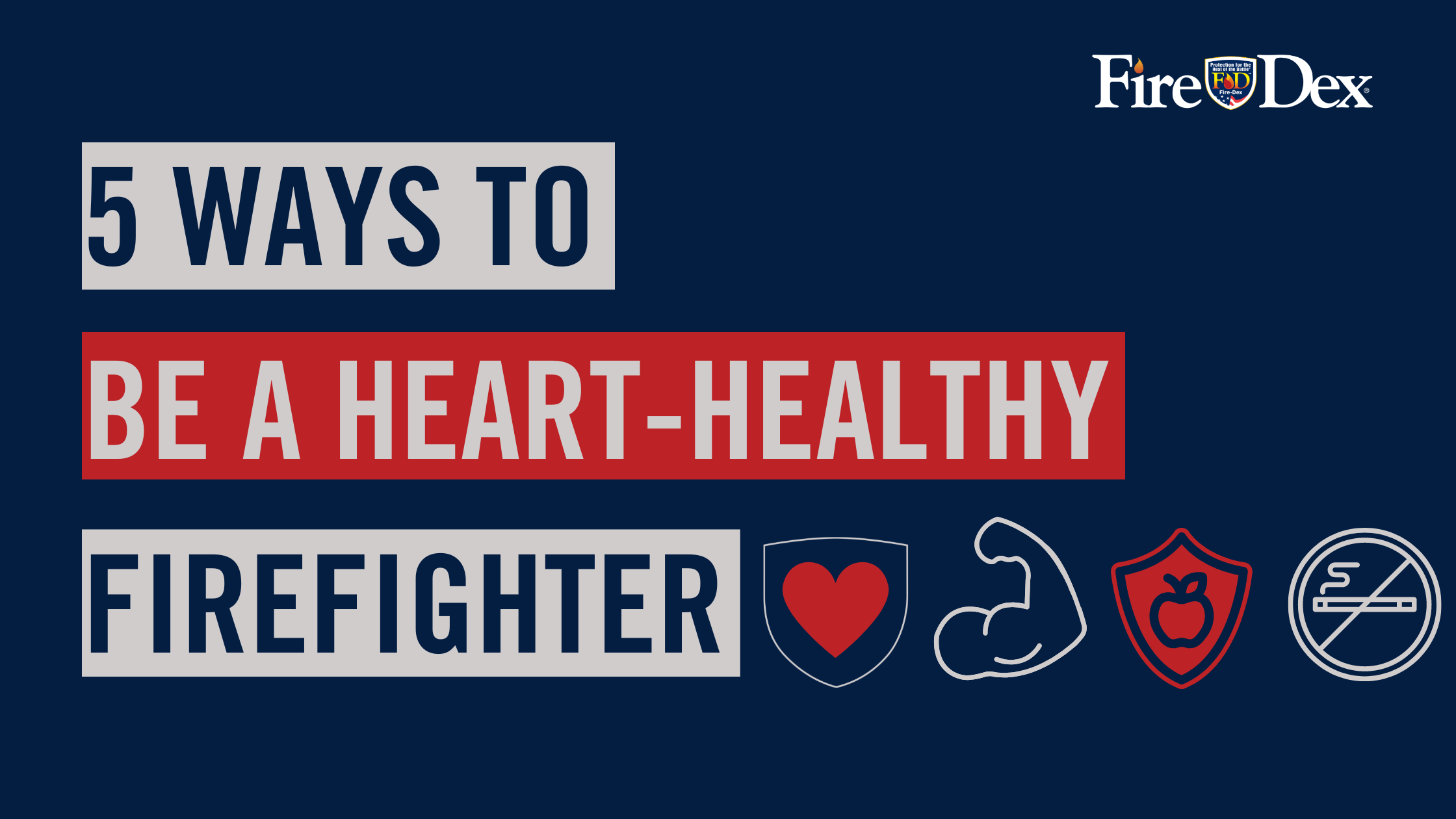Coronary heart disease (CHD) is the most common form of heart disease and is the leading cause of death for all Americans-not just first responders.
According to the National Fire Protection Association (NFPA), in 2021, there were 31 sudden cardiac deaths while the firefighter was on duty, accounting for the largest share of the deaths while on-duty in 2021. Cardiac-related incidences have accounted for 43% of the on-duty fatalities over the past decade.
A heart attack (medically known as myocardium infarction) occurs when there is a blockage in the arteries that supplies blood to your heart. Time is critical when a heart attack occurs and must be treated immediately to prevent permanent heart damage or death.

So, how can you be a more heart-healthy first responder for yourself, your community, your department, and your loved ones? Below are five places to begin.
1. Commit to Intuitive Eating Habits
Intuitive eating integrates instinct, emotion, and rational thoughts to make choices around food that feel good for your body. The key to intuitive eating is focusing on foods that work best for your overall physical and mental health. By implementing intuitive eating choices, you can tap into your body’s unique ability to tell you when you're hungry or satisfied.
4 steps to creating a healthier diet:
- Drink alcohol only in moderation. Excess alcohol consumption can raise your blood pressure and lead to weight gain. If you enjoy alcoholic beverages, limit yourself to a moderate amount (one drink per day for women, two drinks per day for men).
- Read your food labels. The information provided on food packaging is there to help inform you of what the food contains and to provide guidance in making smart food choices.
- Stick to fruits and vegetables. Focusing on a meal plan that contains nutrient-dense foods can help you stay satisfied for longer periods. You want a well-rounded diet high in fiber, proteins, and healthy fats.
- Foods for heart healthy living:
- Leafy greens (spinach, kale, & cabbage)
- Fruits (apples, bananas, blueberries, prunes, & tomatoes)
- Whole grains (oatmeal, brown rice, & tortillas)
- Protein-rich (fish, leafy greens, nuts, legumes, oils, & eggs)
- Foods for heart healthy living:
- Reduce processed and sodium-filled foods. It’s important to avoid fast, canned, or fried foods, and certain condiments to manage hypertension or high blood pressure. Instead, use spices and herbs to add flavor to your home-cooked meals.
2. Get Regular Heart Check-Ups
With routine heart check-ups and screenings, you have the best chance of receiving the correct treatment and diagnosis for any underlying conditions. Many firefighters suffering from heart attacks have pre-existing conditions such as hypertension (high blood pressure) and arteriosclerosis (buildup of fats and cholesterol). Research from the National Heart, Lung, and Blood Institute has found that coronary heart disease (CHD) is the most common form of heart disease and is also the leading cause of death for not only firefighters but all Americans. More than 12 million Americans have CHD, a disease that often results in a heart attack.
During your screening, you can expect your doctor to check for these risk factors by performing a series of tests including:
- Blood pressure test - measures the pressure in the arteries as the heart pumps
- Cholesterol test - determines your risk of the buildup of fatty deposits in your arteries
- Blood glucose test - measures your glucose (type of sugar) levels in your blood
3. Quit Cigarette Smoking
According to the Centers for Disease Control (CDC), cigarette smoking remains the leading cause of preventable disease, disability, and death for Americans, accounting for more than 480,000 deaths each year. Smoking increases the mortality rate for a variety of diseases including lung cancer (125,500); heart disease (101,000); bronchitis, emphysema, and chronic airway obstruction (92,900).
Nicotine is a powerful drug and can be extremely addictive. Quitting is difficult but well worth the effort. When you quit smoking, you reduce your chance of having a heart attack, will live a longer life, and create a healthier environment for those who live with you.
5 steps for quitting smoking:
- Set a quit date
- Talk with your healthcare provider
- Drink plenty of water
- Get medication and use it correctly
- Be prepared for relapse or difficult situations
4. Get Moving with Physical Exercise
As a first responder, you need to be strong enough to stand up to the physical challenges of firefighting and emergency responses. A sedentary lifestyle can lead to major risk factors and a spectrum of diseases that can lower your quality of life. The combination of physical inactivity and poor diet is rapidly approaching the leading cause of preventable death in the world. Increasing your physical activity as an emergency responder is the key to keeping your heart strong, managing your weight, and overall happiness.
Physical activities that can help you get moving:
- Household chores (gardening, raking leaves, or washing your car)
- Water sports (swimming, kayaking, or paddleboarding)
- Strength training (dumbbells or resistance bands)
- Cardio (Pilates, walking, jogging, bicycling, running, or HIIT)
What are the benefits of exercise for your body?
- Improved blood flow throughout your body and increased heart-pumping power
- Increased use in your body’s food supply for better energy output
- Improved brain cognition and reduced risk of dementia
- Reduced depression and anxiety
- Improvements to sleep efficiency and quality
- Maintains your body weight, ability to lose excess weight, and maintain successful weight loss
5. Wear the Right Gear for the Right Call
It’s important to remember that structural firefighting PPE is designed to protect you from the thermal hazards of structural firefighting. When you wear structural PPE in non-fire emergencies such as emergency medical responses or wildland fires, you’re causing unnecessary stress on your body while contributing to repeated exposure to contaminants.
Wearing an alternative garment can reduce your chances of firefighter heat stress and cardiac failure while increasing the lifespan of your turnout gear. As a first responder, the demands of your job continue to evolve. That’s why it’s important to wear the right gear for the right call so you can keep yourself healthier for longer.
Alternative PPE Solutions
Dual-certified to NFPA 1951 (technical rescue) and 1977 (wildland firefighting), our TECGEN51 Fatigues can reduce physical stress and fatigue by requiring less cardiovascular effort than structural firefighting gear. We also offer EMS, USAR, Wildland, and Wildland Tech Rescue firefighting garments.
Check out more firefighter heart-healthy resources:
- National Volunteer Fire Council Heart-Healthy Resource Guide
- NFPA - Firefighter Fatalities in the US in 2021
- IFSI - Firefighter Fatalities and Injuries
Disclaimer: The information on this site should not be used as a substitute for professional medical care or advice. Contact a health care provider if you have questions about your health.







Leave a Reply